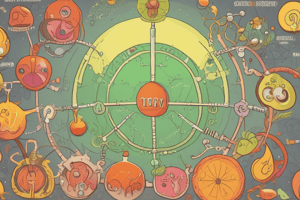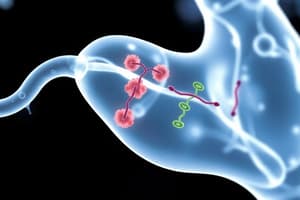Podcast
Questions and Answers
What happens to energy production when pyruvate is blocked from being converted to acetyl-CoA?
What happens to energy production when pyruvate is blocked from being converted to acetyl-CoA?
- Energy production remains unaffected.
- Energy production shifts entirely to anaerobic processes.
- Energy production increases due to alternative pathways.
- Energy production decreases significantly. (correct)
During pyruvate oxidation, what byproduct is released?
During pyruvate oxidation, what byproduct is released?
- Carbon dioxide. (correct)
- Acetyl-CoA.
- Oxygen.
- NADH.
Which part of cellular respiration occurs in the cytoplasm?
Which part of cellular respiration occurs in the cytoplasm?
- Citric acid cycle.
- Glycolysis. (correct)
- Oxidative phosphorylation.
- Electron transport chain.
What is the primary role of oxygen in the electron transport chain?
What is the primary role of oxygen in the electron transport chain?
How many NADH molecules are produced for each acetyl-CoA oxidized in the citric acid cycle?
How many NADH molecules are produced for each acetyl-CoA oxidized in the citric acid cycle?
What is the total ATP yield produced from oxidative phosphorylation?
What is the total ATP yield produced from oxidative phosphorylation?
Which of the following statements about glycolysis is true?
Which of the following statements about glycolysis is true?
What key molecules are produced as outputs of the citric acid cycle?
What key molecules are produced as outputs of the citric acid cycle?
What are the primary products of yeast fermentation?
What are the primary products of yeast fermentation?
Why is glycolysis considered an ancient metabolic process?
Why is glycolysis considered an ancient metabolic process?
What is chemiosmosis primarily used for in cellular respiration and photosynthesis?
What is chemiosmosis primarily used for in cellular respiration and photosynthesis?
Which organisms are thought to have originated photosynthesis?
Which organisms are thought to have originated photosynthesis?
What role do autotrophs play in the ecosystem?
What role do autotrophs play in the ecosystem?
What are the main outputs of the light reactions in photosynthesis?
What are the main outputs of the light reactions in photosynthesis?
What is the main function of carotenoids in photosynthesis?
What is the main function of carotenoids in photosynthesis?
Where does the Calvin cycle occur in chloroplasts?
Where does the Calvin cycle occur in chloroplasts?
What is the main output of the citric acid cycle?
What is the main output of the citric acid cycle?
Where does oxidative phosphorylation take place?
Where does oxidative phosphorylation take place?
Which of the following correctly describes redox reactions in cellular respiration?
Which of the following correctly describes redox reactions in cellular respiration?
What is the total approximate ATP yield from one molecule of glucose during cellular respiration?
What is the total approximate ATP yield from one molecule of glucose during cellular respiration?
During which stage of cellular respiration is the proton gradient established?
During which stage of cellular respiration is the proton gradient established?
Which molecules are primarily oxidized during cellular respiration?
Which molecules are primarily oxidized during cellular respiration?
What is the role of the final electron acceptor in oxidative phosphorylation?
What is the role of the final electron acceptor in oxidative phosphorylation?
Which statement about glycolysis is incorrect?
Which statement about glycolysis is incorrect?
Flashcards are hidden until you start studying
Study Notes
Pyruvate Blockage and Energy Production
- Pyruvate blockage prevents the conversion of pyruvate into acetyl-CoA, halting aerobic respiration and significantly reducing energy production.
- Acetyl-CoA is essential for the citric acid cycle, and without it, the cell cannot generate NADH and FADH2, crucial for ATP production.
Citric Acid Cycle Output
- The citric acid cycle produces 2 ATP molecules, 6 NADH, and 2 FADH2 for each glucose molecule broken down.
- These electron carriers are essential for oxidative phosphorylation, the final stage of cellular respiration, where ATP is primarily generated.
Pyruvate Oxidation
- Pyruvate oxidation occurs before pyruvate forms acetyl-CoA.
- This process releases carbon dioxide and produces one NADH molecule per pyruvate molecule.
Cellular Respiration Overview
- Cellular respiration is the process cells use to convert glucose into energy (ATP).
- It involves glycolysis, the citric acid cycle, and oxidative phosphorylation.
Glycolysis
- Glycolysis breaks down glucose into two pyruvate molecules, producing a small amount of ATP and NADH.
- It occurs in the cytoplasm and does not require oxygen.
Oxidative Phosphorylation
- Oxidative phosphorylation takes place in the inner mitochondrial membrane.
- The electron transport chain utilizes electrons from NADH and FADH2 to create a proton gradient that drives ATP synthesis via ATP synthase.
- Oxygen acts as the final electron acceptor, combining with electrons and protons to form water.
Role of Oxygen in the Electron Transport Chain
- Oxygen is the final electron acceptor in the electron transport chain.
- Its role is crucial for maintaining the flow of electrons and preventing a buildup, ensuring continuous ATP production.
Redox Reactions
- Cellular respiration involves redox reactions where glucose is oxidized (loses electrons) and oxygen is reduced (gains electrons).
- Energy released during these reactions is captured and used to produce ATP.
Energy Content of Macromolecules
- Carbohydrates and fats are rich in energy due to their many electrons, releasing energy when oxidized during metabolic processes.
ATP Production
- ATP production during cellular respiration:
- Glycolysis yields 2 ATP
- The citric acid cycle produces about 2 ATP
- Oxidative phosphorylation generates approximately 30-34 ATP
- The total ATP produced from one glucose molecule during cellular respiration is about 32 ATP.
Proton Pumping in the Electron Transport Chain
- Protons are pumped across the inner mitochondrial membrane during the electron transport chain.
- This creates a proton gradient that powers ATP synthesis.
Yeast Fermentation
- The net output of yeast fermentation (alcohol fermentation) is ethanol and carbon dioxide.
Universality of Glycolysis
- Glycolysis is ubiquitous in nearly all living organisms and requires no oxygen.
Chemiosmosis
- Chemiosmosis uses a proton gradient to drive ATP synthesis.
- It is a common mechanism in both cellular respiration and photosynthesis.
Origin of Photosynthesis
- Cyanobacteria are thought to be progenitors of photosynthesis, capable of oxygenic photosynthesis.
Autotrophs and Photosynthesis
- Autotrophs produce their own food through photosynthesis, using light energy, carbon dioxide, and water.
Respiration in Plants
- Plants engage in cellular respiration, which takes place in the mitochondria.
- The Calvin cycle (light-independent reactions) occurs in the stroma of chloroplasts.
Products of Light Reactions in Photosynthesis
- The light reactions in photosynthesis produce NADPH and ATP.
Pigment Absorption
- Chlorophyll absorbs specific wavelengths of light, as indicated by its absorbance spectrum.
- Other pigments become dominant when leaves change color in the fall, leading to changes in light absorption.
Electron Acceptor in Photosynthesis
- NADP+ acts as the final electron acceptor in Photosystem I.
Functions of Carotenoids
- Carotenoids protect photosystems from damage caused by excess light.
- They also contribute to light energy capture for photosynthesis.
Calvin Cycle and CAM
- The Calvin cycle occurs in the stroma of chloroplasts, where carbon dioxide is fixed by rubisco.
Studying That Suits You
Use AI to generate personalized quizzes and flashcards to suit your learning preferences.




